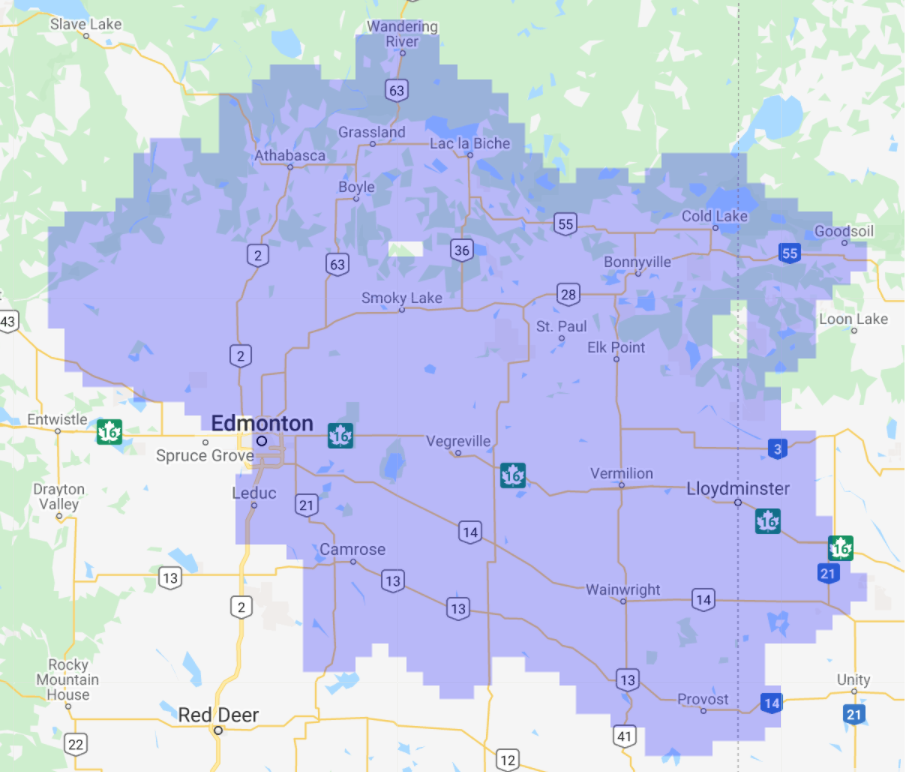Federal grant matching helps companies like MCSNet increase service levels across northeastern Alberta
LAKELAND – Communities across northeastern Alberta will soon have more access to high-speed internet thanks to the newest expansion of the province’s broadband strategy.
Five counties — Athabasca, Westlock, Lac La Biche, Two Hills, St. Paul and Lamont — will receive over $16.2 million in investment from MCSNet thanks to the matching grant program from the provincial and federal governments.
“High-speed internet is no longer a luxury, it’s a necessity,” said Rhonda Lafrance, MCSNet’s chief marketing officer. “We saw that during the pandemic. Everyone had to move home for school or work.
“We need it for our everyday lives. If we want to maintain our rural homes and communities and compete with people in cities, we need to develop those same types of technologies in rural areas.”
MCSNet, a family-run internet service provider (ISP) from St. Paul, is already the primary service provider for rural communities in this region, but the money will help them expand their fiber lines further.
Lac La Biche County will see 55.83 km of fiber at Skeleton Lake, Caslan, Hylo and east.
The MD of Bonnyville will see 13.01 km of fiber at Highway 41 through Kehewin, Highway 882 south of Beacon Corner.
Two Hills County will see 53.79 km of transit fiber along Highway 36 through Two Hills and towards St. Paul.
The County of St. Paul will see 85.9 km of fiber along Armistice Road to Elk Point and Highway 646 to Lindbergh, Highway 866 north to Floatingstone Lake, Boyne Lake and east on Township Road 614 to St. Lina.
Regional hubs
The overall goal of the new fiber lines is to connect MCSNet’s fixed wireless towers to enable a technology the company calls GigAir. Using 60 gigahertz radios and millimeter waves, MCSNet can chain together houses in higher density regions, like summer villages or hamlets, to make a “mesh net” of internet coverage.
“The connection goes from the tower to the first home, and it runs from one house to the next,” said Lafrance. “It has a short range, only about 200 metres, so it can go from one home to another.”
The technology has been showcased to full effect in Barrhead County, where a 2022 partnership between the municipality and MCSNet saw the fiber lines extended into Minola and Neerlandia. In total, the ISP extended 58 kilometres of broadband fiber in the area.
“The county contributed 50 per cent of that funding for those extra stretches of fiber, which is phenomenal,” said Lafrance. “They know they’re investing in something that helps their ratepayers.”
Rural residents also benefit from technology like GigAir, even if they can’t access the service themselves. When denser areas move off a fiber line, it means less data is being pulled from the line, meaning acreages and farmhouses see higher upload and download speeds on their internet.
In 2022, Rural Municipalities of Alberta conducted public-led internet speed tests throughout rural Alberta. When the studies closed in October of that year, it concluded that rural Albertans experience much lower internet speeds than the 50/10 Mbps goal of the federal government. According to Lafrance, the average speed across MCSNet’s network, which spans from Provost to Wandering River, and goes as far east as Goodsoil in Saskatchewan, is 60/15 Mbps.
Nate Glubish, Alberta’s minister of technology and innovation, said high-speed internet levels the playing field for rural Albertans.
“I’m confident that we are on track to achieving our goal of connecting every single Alberta household to high-speed internet by 2027,” said Glubish.
In the March 5 announcement, the province said it expects that within three years of completing universal coverage, up to $1.7 billion in annual GDP growth would occur, and 2,000 long-term service-industry jobs could be created in rural communities.

Tyler Fields is your internet guru, delving into the latest trends, developments, and issues shaping the online world. With a focus on internet culture, cybersecurity, and emerging technologies, Tyler keeps readers informed about the dynamic landscape of the internet and its impact on our digital lives.


